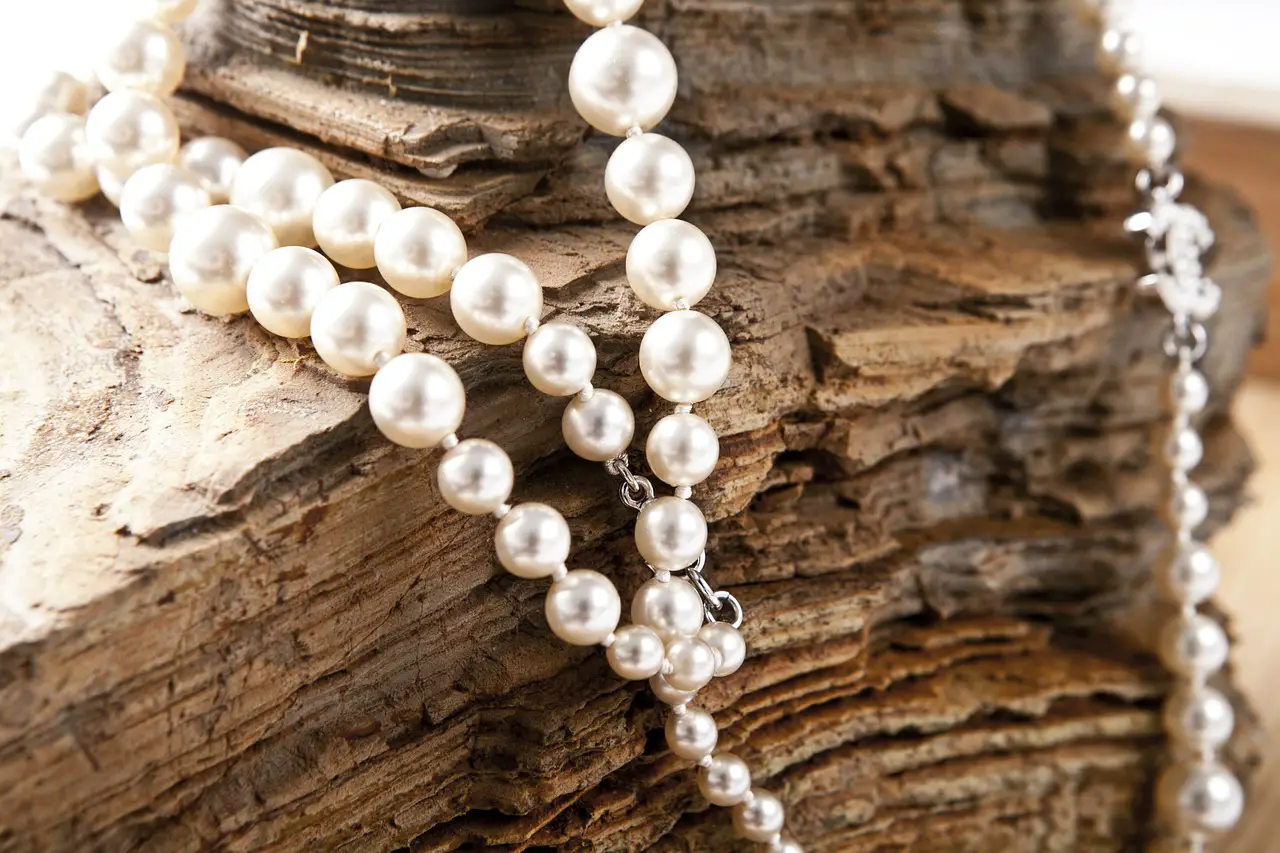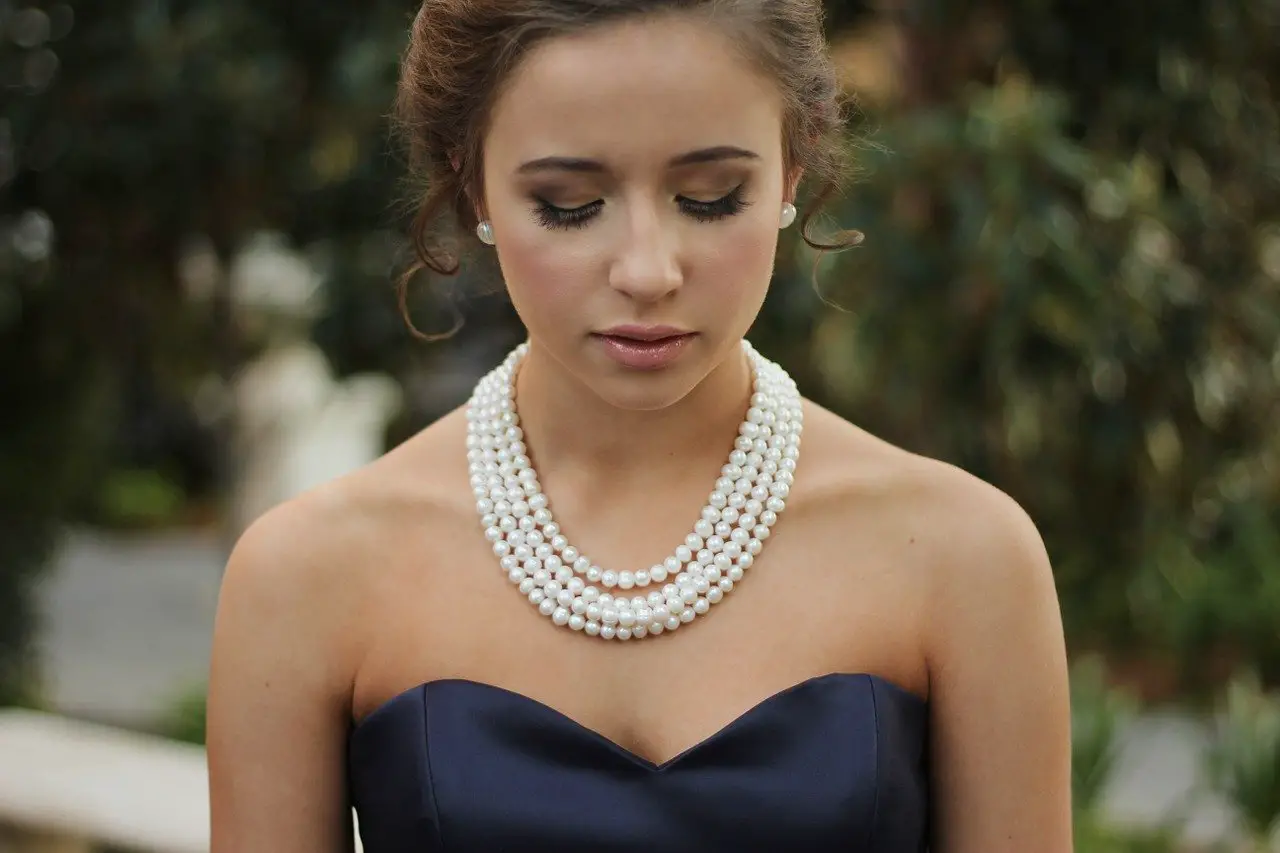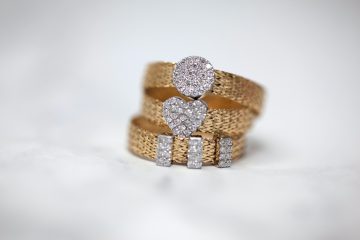Pearls belong to the group of precious stones and are valuable natural products. Jevelia offers both cultured saltwater aqua pearls and cultured freshwater pearls at competitive prices. Marine cultivated pearls are a collective term for pearls grown in a saltwater environment. There are a number of different types of pearl mussels around the world that thrive in saltwater.
Akoya pearls
Akoya pearl is called the classic Japanese and Asian pearl. In Japan, pearls are now cultivated for over 100 years in mussels called Akoa-Gai and Pinctada Martensi Fucata, which is the scientific name.
On Japan’s southern coasts are the largest pear crops. The Akoya-Gai mussel is small and grows up to about 10 cm and produces cultured pearls in the size of 2-10 mm. The beads are carefully sorted according to different criteria. The most common bead sizes sold in jewelry are 6-7 mm. Already at 8 mm bead size prices rise rapidly due to rarity and at a further every 0.5 mm prices rise further sharply.
The beads are usually harvested in the winter when the water is colder. During this time, each layer of the pearl substance also becomes thinner, giving the best luster. During the summer, each layer of the pearl substance becomes more powerful, but the luster in reverse mats. Each day, mussels create 3 – 4 layers of bead substance on average. There will be several thousand layers of pearl substance around the pearl ball during a cultivation period of 3 years. A cultivated (cultured) quality pearl has about 0.5 mm pearl substance.
A cultured (cultivated) saltwater aqua pearl is a pure natural product consisting of about 86% calcium carbonate, 12% conchyoline, and 2% water. Calcium carbonate is formed both as calcite or aragonite. The organic substance Conchyolin is a horn substance that binds the aragonite crystals. The mussel’s natural color spectrum can result in the pearls being able to get colors in white, pink, green, yellow, and blue-gray shades. Only about 3% of the total production consists of beads with blue-gray tint.
After harvest, the Akoya pearl mussel has finished producing. Akoya pearls are mainly offered in the colors white, silver, pink, and champagne. “Black” pearls are rare. In Japan and other Asian producer countries, advanced treatment methods have been developed for many years that make it possible to refine cultivated Akoya raw beads. First, the beads are drilled, then bleaching, staining, and polishing. Finally, stunning and very stylish pearl jewelry is made in more elegant colors and shades compared to the natural main colors.
The following forms are found: globular, oval, button-, drip- and baroque-shaped beads. The value of cultivated Aoya beads mainly depends on size, shape, color, luster, and surface quality. Generally, cultivated saltwater Akoya beads are significantly more expensive than cultivated freshwater beads as the Akoya beads grow slower and the mussels produce small harvests.
The Akoya mussel is constantly threatened by environmental toxins, emissions, and pollution in the seas around Japan and the Asian countries.

Freshwater pearls
As cultured freshwater pearls are referred to as pearls that are not cultivated in the sea but in lakes. Most famous is the Biwa pearl, which has been named after Japan’s largest lake, Lake Biwa.
The variations in shape, color, and size have made freshwater pearls popular. They are available in sizes from 2 to 8 mm, the average is 4 to 5 mm. Cultured freshwater pearls with a size exceeding 10mm are rare. Freshwater pearls grow much faster than saltwater Akoya pearls. Therefore, the price of freshwater pearls is much cheaper than for Akoya pearls.
Freshwater pearls are available in the colors: white, cream, champagne, orange-pink, purple, light violet, dark brown, and brown. The shapes have a span from oval, egg shape, button shape, drip, and potato shape. Today, almost completely round freshwater pearls can be cultivated up to a remarkable size of 8 mm.
South-sea pearls are cultivated pearls just like the Akoya pearls. But, in some important points, they differ: The size of the South Sea pearls ranges from 8 mm to 22 mm. The color spectrum ranges from white, golden yellow, silver-gray, but also rosé, gold, gray, and dark gray. The best quality pearls come almost exclusively from Australia. Indonesia and the Philippines have the most pearls in a cremation color.
Cultured pearls from the black-lipped pearl mussel Pinctada margaritifera are referred to as Tahiti pearls. They are cultivated in French Polynesia. The Pinctada margaritifera mussels with their green-black-laced pearl tissue have always been praised for their exceptional properties: the thickness and quality of the pearl substance and the depth, and the brilliance of the colors. The pearl mussel Pinctada Margaritifera is, as far as the colors are concerned, the most versatile mussel.
The color of the pearl cannot be affected and is believed to be entirely dependent on the individual mussel’s properties. There is no knowledge whether in some lagoons or in certain water temperatures it is more common with some colors than others, ie. that the mussel cannot be “programmed” by man to get a certain color.
The size of the beads ranges from 8 mm to 19 mm. Tahitian pearls have a very wide color spectrum. Anthracite with different shades is the most common color.
Exclusive “peacock-color”, which shines in all the colors of the rainbow is the most expensive. After that comes intensive green-black, then grayscale and finally yellow colors. These beads are appreciated and are called the “Queen of the Pearl”
Polynesian bivalve molluscs can grow as healthy and strong specimens up to 30 years old, reach a respectable size of 30 cm in diameter, and gain weight of 5 kg. They grow in the blue-turquoise colored lagoons where the water temperature is 24 to 29 degrees Celsius.

Pearls are graded
The beads are sorted by shape, surface, the thickness of the bead substance, and luster. About 1% of the pearl crop gives pearls with excellent shine and they are 96% stain-free and match each other excellently.
Even the pearls that come from the top 5% of the harvest have excellent shine and they are 90 to 95% stain-free. They match each other very well and have a round shape and a thick mother-of-pearl layer.
The next category is the pearls that belong to 20% of the harvest. Their luster is good and they are 80 to 90% stain-free. They match each other well in appearance, the beads are relatively round in shape and the thickness of the mother-of-pearl layer varies from medium to thick, i.e. the beads are of high quality.
Pearls that come from the proportion of 50% of the harvest have normal shine and their spots are negligible and a few. They match each other in appearance and have a round to off-round shape. Here, too, it is all about beautiful beads that hold class and fine quality.
When it comes to Akoya pearl necklaces, there are always several options to choose from for the jewelry lover. Is there a difference between Japanese pearls and Akoya pearls from other Asian countries?
When it comes to pearls, Japan still has the best and most valuable pearls, because Japan’s pearls have the best spherical shape. In the pearl industry, the rounder the pearl the higher the price.
Japanese Akoya pearls are the watch type for the classic quality and standard of what a pearl necklace should be. Pearl growers in Japan’s pearl farms are among the world’s highest-paid labor. This is very much due to the sad process of growing and obtaining pearls from oysters and mussels.
It is true if consumers buy Akoya pearl necklace just because the norm for this fine jewelry continues to prove to be style-forming. What is important in this context is that these standards stand for first-class beauty and beauty, luster and elegance in the Akoya pearl band – whether it is pearls from Japan or from other Asian countries. It’s all about these exquisite beads giving the wearer the sheen of class.
History of pearls
Throughout history, pearls have been known and appreciated in many cultures. Since 2300 BC, Chinese stories point to the pearl as a valuable property of the nobility and as a gift to emperors and kings. In fact, pearls have been a part of many Mystery short stories over the centuries and decades.
Ancient Hindu texts from India also repeatedly refer to the pearl, it is even claimed that the god Krishna discovered the world’s first pearl. In ancient Egypt, mother of pearls was appreciated as decoration, although the use of the actual pearl came much later, about 5 centuries before Christ.
Even the ancient Romans appreciated pearls, especially as a prestige object and symbol of welfare – a great deal of effort was put into prohibiting “unworthy” of wearing pearls. By far the most festive event in the history of Roman history has to do with a banquet organized by Cleopatra, the last queen of Egypt, for the Roman Imperator Markus Antonius.
The ancient Greeks appreciated pearls a lot, especially at weddings, when the pearls were attributed to bringing love. Because of many pearl beds in the Persian Gulf, pearls were of great value to the Arabs as well. The Qur’an describes the pearls as one of the paradise’s most precious treasures.
In the western hemisphere, freshwater pearls were very popular with Native American residents who harvested pearls from rivers and lakes. A tradition story, for example, tells of a Native American princess that Hernande de Soto gave valuable gifts: animal skins, fabrics, cups, and freshwater pearls.
Seafarers from Spain, France, and England discovered all-natural strains that used beads in jewelry and traded with them. Pearls, as soon as they discovered their incredible presence in the American rivers, became one of the most sought after products sent to Europe.
With the freshwater pearls from the North American rivers, saltwater pearls soon also traveled from the Caribbean and from the coasts of Central and South America to the countries of Europe.
The flood of pearl supplies diminished in the 20th century when the hopeless plunder of the occurrences and environmental degradation through industrialization put an end to it.
In addition to the pearls themselves, American mother of pearls became an export success, both from the North American colonies and later, from the United States. The main area of use for the mother of pearl was the manufacture of shimmering, shiny buttons. Of these, billions (mostly from Iowa) were exported to the whole world, up to the mid-1900s, when they were quickly replaced with plastic buttons which had been invented then.
During the latter part of the 19th century and the early 1900s, the history of pearls reached a turning point. At this time, some Japanese scientists, independently of one another, discovered a method that made it possible to stimulate oysters to produce pearls. The person who finally coordinated all the processes had a business sense and was able to link this with a world-wide market knowledge was Kokichi Mikimoto, the son of an innkeeper. Today, Mikimoto is attributed to the fact that he himself created the world-wide cultural pearl industry.
How to take care of pearls
Pearls are natural products. Therefore, the surface of the beads is soft and delicate. By contact with gems and metals, the beads can be easily scratched. Keep the pearl jewelry separate from other jewelry, it is best to put each pearl jewelery individually in a silk bag or in a wrapper with a thin, soft linen fabric. Do not store in cotton as this will dry out the beads. Do not use a leather bag or leather case for the storage of beads as the tanning acid can damage the luster.
Do not expose your pearl jewelry to strong sunlight. Refrain from wearing beads when sunbathing. Sweat and sunscreen attack the surface of the beads. Solar radiation and storage near heating elements cause dehydration of the outermost bead layer because the bead substance contains water.
Refrain from wearing the pearl jewelry at the daily shower or in the bath. This also applies to bathing in the sea or swimming pool. The seawater is not free from pollution and the water in the swimming pool contains a number of chemical substances, for example, chlorine.
Also, handle cosmetics with care. Avoid spraying perfume on the skin areas where the pearl jewelry is located. We recommend that you put on the pearl jewelry when you are done with the hairstyle and makeup.
Do not wear the pearl piece on skin that has been treated with cream. Protect the beads from cosmetics as they contain grease, acids, and bleach. Avoid contacting the beads with skin ointment, creams, soaps, shampoos, hair dyes, and more. preparation.
Avoid exposing the beads to large temperature differences. If you have worn the beads against warm skin, you should avoid putting them on a cold plate as the beads can then crack.
Pearls cannot withstand detergents. Clean the beads after wearing them with a damp linen cloth. Never use unsuitable preparations and agents such as a brush, eyeglass cleaning cloth, or any other chemically treated cloth. Do not clean your pearl jewelry with plenty of water, as wet silk threads can in some circumstances be more easily damaged and therefore you may lose the pearl necklace.
A pearl necklace is there to wear if you wear it often, we recommend that you have a jeweler check it once a year and have it reassembled if necessary. If you only wear the pearl jewelry sometimes, it can take several years between checks and any action. Keep in mind that nothing would be more annoying than seeing the valuables roll around on the floor.
Lubricate the beads with olive oil every two years to maintain their shine.
If you follow these instructions, you will enjoy the pleasure of your pearl jewelry for many years and the pearls will give you thanks to maintained luster and longevity.



